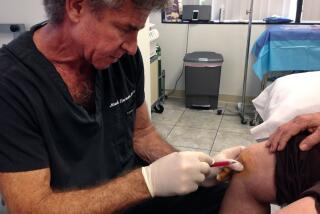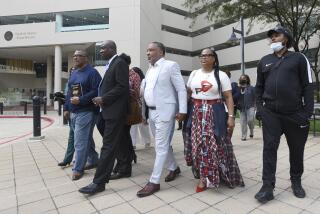NIH Identifies Stem Cell Sets OKd for Funds
- Share via
WASHINGTON — Federal officials Monday identified the owners of 64 sets of stem cells from human embryos that can be used in government-funded experiments, an important step for researchers who want to obtain the scarce cells and use them in the hunt for new cures for diseases.
After scouring the international research community, the National Institutes of Health announced that it had found 10 laboratories in five countries that had taken stem cells from embryos before a cutoff date imposed by President Bush.
However, some scientists and advocates for patients questioned whether the 64 sets were numerous enough, and of high enough quality, for researchers to explore the full promise of stem cells in medicine. One San Diego company identified by the government said it was months away from being able to release its cells to other researchers.
In the Senate, lawmakers are preparing for hearings that could lead to legislation making more cells available to federally funded researchers.
“There’s a lot more we need to know about the quality of these cells and about whether they are subject to patenting or licensing agreements” that might prevent them from being widely distributed to researchers, said Anthony Mazzaschi of the Assn. of American Medical Colleges, which supports embryonic stem cell research.
The focus on the 64 cell sets arose because Bush, in a nationally televised address Aug. 9, said he would allow federal money to pay for experiments that used only stem cells already taken from embryos before his 9 p.m. EDT speech, preventing the need for additional human embryos to be destroyed.
Bush said his decision was an attempt to balance the hope that stem cells might be fashioned into medical treatments with his qualms about destroying “human embryos that have at least the potential for life.” The Roman Catholic Church and anti-abortion groups have said that dissecting embryos for their stem cells is equivalent to murder.
Of the labs listed by the NIH, four are in the United States, with the rest in India, Sweden, Australia and Israel. Among them, the labs have 64 colonies of stem cells, or cell lines.
“The NIH has met or spoken extensively with each of the investigators who have derived these cells,” the agency said. “These scientists are very interested in working with the NIH and the research community.”
The NIH also said that many, though not all, of the cell lines had passed a test that shows they can grow into more specialized types of cells and tissues--the biological feature that has drawn such wide attention to embryonic stem cells. Researchers are hoping the cells can be a source for creating replacement tissue for diabetics, Parkinson’s disease patients and others whose own tissues have gone awry.
But some advocates for patients said they needed to know more about the biological characteristics of the approved stem cell lines and about the conditions for their release to researchers.
The cell lines are privately owned, many by companies that will likely want to retain rights to any discoveries made with their cells. The NIH has no power to compel cell owners to work with researchers or to set the terms of their agreements.
The Coalition for the Advancement of Medical Research, which consists largely of patient advocacy groups, said it was particularly concerned that some of the overseas labs may have created their cell lines using techniques covered by U.S. patents. That could raise tricky legal questions if those cells are transferred to researchers in the United States, the group said.
Researchers will have to form their own alliances with cell owners before asking the government for funding. The NIH previously said the first grants would be awarded next year.
One company on the NIH list, CyThera Inc. of San Diego, said it has to study and refine its cell colonies before releasing them to other researchers, a process that could take months.
The NIH said CyThera had nine stem cell lines, more than any other team except one at Goteborg University in Sweden. But Dr. Michael J. Ross, president of CyThera, said the company did not yet have true stem cell lines.
Before Bush’s Aug. 9 cutoff, Ross said, the company had taken from nine embryos a structure called the inner cell mass, which contains 50 to 200 cells. To create a cell line, scientists have to complete the tricky process of taking any one of those cells and prompting it to reproduce again and again, growing into a colony.
“We could end up with more than nine cell lines or less than nine cell lines,” Ross said.
CyThera’s appearance on the NIH list was something of a surprise. Most of the public attention has gone to the University of Wisconsin, whose researchers were the first to isolate and grow human embryonic stem cells.
CyThera was founded in January 2000 with the goal of using embryonic stem cells to create insulin-producing tissue for transplantation into diabetics. It has 10 employees. “We kept pretty quiet on purpose, because obviously there was so much controversy around this, and so there was no reason to be in the limelight,” said Dr. Lutz B. Giebel, the company’s chief operating officer.
Giebel said CyThera expected to distribute its cells widely to other researchers, but within limits. “Obviously, we don’t want to enable our competition,” he said.
Sens. Edward M. Kennedy (D-Mass.) and Arlen Specter (R-Pa.) have planned two committee hearings that congressional aides said could lay the groundwork for legislation aimed at broadening Bush’s restrictions. Specter and Sen. Tom Harkin (D-Iowa) have filed legislation that would greatly boost the number of cell lines available for federally funded researchers.
One leading biologist said at least four labs on the NIH list are “very high-class operations” and account for 30 to 40 of the cell lines, enough to ensure that research will advance.
“Forty lines is a lot of stuff to work with,” said Dr. Paul Berg of Stanford University. “It seems a little premature to wring our hands when we haven’t had a look or attempted to work with the existing stem cell lines.”
Other U.S. labs on the NIH list are the Wisconsin Alumni Research Foundation, owner of five cell lines; BresaGen Inc. of Athens, Ga., with four cell lines; and UC San Francisco, with two lines.
(BEGIN TEXT OF INFOBOX / INFOGRAPHIC)
The 10 Labs That Qualify
Companies and research laboratories with stem cell lines:
*
*--*
Name Location No. of lines BresaGen Inc. Athens, Ga. 4 CyThera Inc. San Diego 9 Goteborg University Goteborg, Sweden 19 Karolinska Institute Stockholm 5 Monash University Australia 6 Nat. Center for
Biological Sciences Bangalore, India 3 Reliance Life Sciences Mumbai, India 7 Technion-Israel Institute of Tech. Haifa, Israel 4 UC San Francisco San Francisco 2 Wis. Alumni Research Foundation Madison, Wis. 5
*--*
Source: National Institutes of Health
More to Read
Sign up for Essential California
The most important California stories and recommendations in your inbox every morning.
You may occasionally receive promotional content from the Los Angeles Times.









